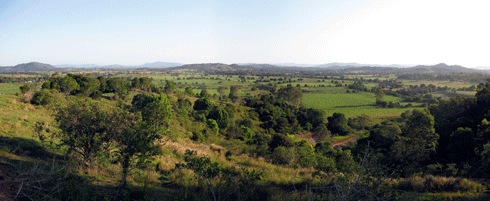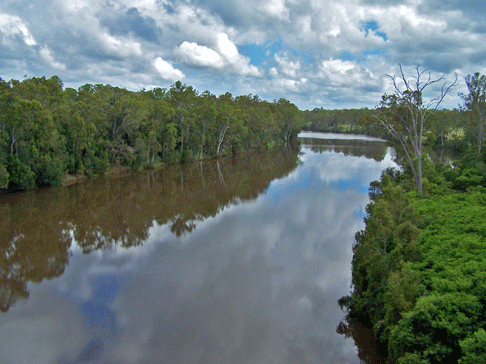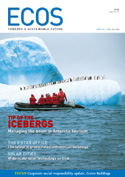Published:
Towards a systems-based approach to planning infrastructure
Integrating the need for major infrastructure development with an ongoing commitment to communities and the environment is the driving force behind a new approach for sustainable development in major projects in Australia.

|
|
The Traveston Dam site taken from the planned location of the dam wall. Credit: c/o QWI
|

|
|
The Mary River downstream from the Traveston Dam site, towards Maryborough. Credit: Courtesy BMRG
|
South-east Queensland, like other parts of Australia, is facing increasing pressure on water resources and trying to balance demands of a growing population with a sustainable water supply.
The region’s population is expected to grow from 2.8 million to up to six million by 2050. While dams and weirs previously provided 95 per cent of south-east Queensland’s drinking water, the Queensland Water Commission’s draft strategy released in 2008 identifies a gradual push towards desalinated and purified recycled water providing up to 30 per cent of the region’s supply from climate resilient sources by 2056.
Water consumption in the region, even with tough restrictions, is expected to double from 480 000 megalitres (ML) annually to more than 800 000 ML in the next 40 years.
Daniel Spiller, Acting Executive Director of regional planning and policy for Queensland Water Commission, said the forecast water use was based on a reduced water consumption of 300 litres per person per day pre-drought to 230 litres per day.
And, the commission’s modelling predicts that an additional 97 000 to 308 000 ML per year (on top of what comes from the South-East Queensland Water Grid) will still be needed by 2056, of which 69 000 to 203 000 ML per year will need to come from ‘climate resilient’ sources.
The $9 billion South-East Queensland Water Grid includes a $2.5 billion recycled water project which promises to deliver up to 232 ML of purified recycled water a day as well as a desalination plant that began distributing desalinated water into the grid in February 2009. The grid integrates the region’s eight water supply systems.
The controversial (still to be approved) Traveston Crossing Dam on the Mary River is seen as part of the ‘missing link’ in the water grid.
Chris Davis, Sustainability Business Development Manager at the Institute for Sustainable Futures at University of Technology Sydney (UTS), and a National Water Commissioner, says with the highest rate of population growth in the country, managing water supply in south-east Queensland is a challenge.
Mr Davis said the other issue is that our historic knowledge of hydrology is of very little use in the new world of climate change, superimposed on what is probably a natural variation over many decades.
‘Twenty years ago hydrologists confidently predicted what sort of range of expectations one could have about runoff and now it is very hard to do that,’ he said.
New engagement for best outcomes
In 2006, the Queensland Government established Queensland Water Infrastructure (QWI) to develop and manage major water infrastructure projects in south-east Queensland, including the Traveston Crossing Dam and the Wyaralong Dam (on the Teviot Brook in the Logan River catchment).
QWI engaged CSIRO Sustainable Ecosystems in the early planning stages of the Traveston Crossing Dam to develop an innovative sustainability framework and guiding principles for its optimal development in the Mary River region, provided it is approved and undertaken.
CSIRO Sustainable Ecosystems has been working with industry to develop solutions to deal with the challenge of social, economic and environmental sustainability.
The principles they have developed for QWI’s project focus on three areas: sustainable communities, sustainable enterprises and ecologically sustainable catchments.
The type of initiatives to be developed by QWI under these broad themes include, for example, developing options for relocating displaced residents within the local area, creating employment opportunities during construction, and encouraging restoration of riparian vegetation and wetlands.
Leader of the project, CSIRO Sustainable Ecosystems Deputy Chief, Allen Kearns, said, surprisingly, this systems-based approach was quite novel for planning major infrastructure projects which are usually assessed by proponents using almost purely financial criteria.
‘They will have to prepare an environmental impact statement (EIS), and may even have some form of social impact assessment, but adopting a clear set of overarching sustainability principles is quite unusual,’ said Mr Kearns.
He said what was new about the approach was the high level of engagement by CSIRO with QWI in the decision-making and development of a customised design process for the sustainability principles around their Traveston project.
‘It wasn’t a star rating system brought in from somewhere else or a generic approach. It was based on the opportunities identified from that particular project and developing them into a plan,’ he explained. ‘It would be valuable to be able to use these sorts of sustainability principles to assess other infrastructure projects in Australia.’

|
|
QWI has provided a new locomotive to the Mary Valley Heritage Rail Society to help ensure the long-term future of the tourism icon, important to local business viability. Credit: c/o QW
|
Broadening evaluation
In the second phase of the collaboration, CSIRO will monitor and evaluate the project’s performance in meeting the sustainability principles. An evaluation framework will be formulated for sustainable development indicators to assess project outcomes and progress.
‘This is an extra level of performance on top of the company’s obligations to meet its EIS requirements and project approval conditions,’ said Mr Kearns.
‘We weren’t involved in any sort of alternative assessment about whether the water requirements of south-east Queensland could be managed or planned in another way. We are looking purely at how the project should move ahead in terms of sustainability directions, and identifying some clear principles that could be evaluated if the dam is approved,’ he said.
Keeping aside the issue that a large man-made construction undoubtedly impacts the original environment, the challenge and aim is to best assess how the development of the project could create some counterbalancing environmental and community gains.
QWI CEO Graeme Newton takes the view that infrastructure has the potential to deliver more than just the end product – be it a road or a dam. As part of the environmental impact statement (EIS) terms of reference, the company must demonstrate how it will respond to social and economic impacts as well as environmental ones.
To meet these requirements, projects usually need to undertake offsets or mitigation measures, but, Mr Newton said he wanted to take the project to another level.
‘If it’s a dam, let’s have it provide more than just water – a venue for recreation or opportunities for forests on some of the excess land so that we can create a timber industry with long-term sustainable jobs and also ensure better quality water runs off into the system,’ he said.
‘The guiding principles provided by CSIRO gave us the opportunity to identify initiatives and projects, such as links with other research institutions to monitor and measure our activities, to demonstrate that we have made that contribution,’ he said.
Mr Newton said part of the company’s commitment to local enterprises was to engage local suppliers on the dam’s construction. The company has set up registers for local suppliers and services as part of the required approval process in the dam’s EIS. Since the register opened in 2007, it has received more than 1300 registrations from interested businesses.
Queensland Water Commission’s Daniel Spiller said his organisation was trying to embed a triple-bottom-line approach [environment, community and economics] to total water cycle management in the region so it was encouraging that QWI and CSIRO were taking the new approach in delivering their project. ‘The strategic level appeals to us,’ he said.
As part of its commitment to improving the catchment, QWI has established a trial native tree plantation next to the Traveston Crossing Dam site. This will eventually be part of a much larger 2000 ha revegetation program designed to restore original vegetation patterns, which could also boost the local timber industry. The plantings will also offset the CO2 emissions from the dam’s construction, according to QWI.
Collaborating on post-development impacts
The project’s second phase will include more involvement with regional and local stakeholders.
‘We will be looking at the environmental and social impacts on the Mary River region – and relating that scale to south-east Queensland – as a whole,’ said Mr Kearns.
The monitoring and evaluation work will also involve other research collaborators. The University of Queensland has been given funding to establish a freshwater species conservation centre at the dam site to research vulnerable species such as the Queensland lungfish, Mary River cod, Mary River turtle and southern barred frog. And QWI has engaged Griffith University to provide a carbon accounting system that verifies the project’s planned carbon offsets. The university will also undertake a continual audit and provide scientific advice on the development of native timber plantations.
Mr Kearns emphasised the catchment-scale approach. ‘There is a real need for vegetation and revegetation along the riparian edge,’ he said. ‘Streamsides, as well as large areas of the catchment, have been cleared for dairying and other grazing.
‘Establishment of the freshwater research station by the University of Queensland is recognising that research is really important and there are knowledge gaps around the existing habitat quality for survival of those species, as well as the altered habitat quality once the dam is constructed.

|
|
An architect’s impression of the QWI-funded Freshwater Species Conservation Centre. Credit: c/o QWI
|
‘QWI is also addressing these issues by setting up management practices that would start to put back some of that habitat quality that has been lost after decades of agricultural change in that [Mary River] valley.’
But Chris Davis from UTS said it was still a moot point whether the investment and environmental impact would be warranted in terms of any outcomes for the community.
He also reflected some wider concerns about the tendency for decision makers to prefer infrastructure solutions over demand management options.
‘There is a bias in government towards hardware options rather than efficiency gains when it comes to ways of balancing the water budget, which means we are setting ourselves up to have a less sustainable outcome,’ Mr Davis said. ‘Water restrictions during the drought reduced Brisbane’s consumption to 140 litres per person per day – the country’s most frugal rate.’
However, as Daniel Spiller from the Queensland Water Commission highlighted, with the full impacts of climate change on water supply still imprecise, the state government is planning a mixed strategy, including efficiency measures already underway, with some climate resilience embodied in its ‘hardware’ water grid.
‘Our water strategy has a big focus on pressure reduction, leakage management, local recycling schemes to supply industry, work on stormwater harvesting and research on improving irrigation efficiency,’ Mr Spiller said. ‘Reducing consumption and encouraging water recycling is the number one thing we are doing,’
QWC’s forecasts are based on people using water 24 per cent more efficiently than pre-drought trends.
This is where the project’s collaboration engages again – the University of Southern Queensland is researching climate forecast systems for rainfall and stream flow in the region.
The University of the Sunshine Coast, meanwhile, is measuring the activities of other major regional infrastructure projects, including other elements of the South-East Queensland Water Grid and the Woolooga to Cooroy power transmission line construction occurring in the same area.
CSIRO’s wider monitoring and evaluation will take place at a number of levels: from the social impacts – assessment of quality-of-life impacts on local, regional and more distant communities – to the environmental impacts on the catchment.
This information could help improve the sustainability of other infrastructure projects in Australia and elsewhere. Mr Kearns hopes that at least one of the outcomes will be improved planning and appraisal systems, and a greater emphasis on broader social and environmental objectives. That would be a move away from economic returns and other financial considerations being the main criteria for success.
More information:
CSIRO Sustainable Ecosystems,
www.csiro.au/org/CSE.html
Queensland Water Infrastructure,
www.qldwi.com.au
Queensland Water Commission,
www.qwc.qld.gov.au



